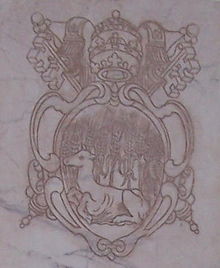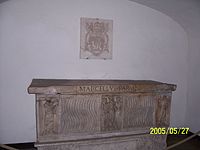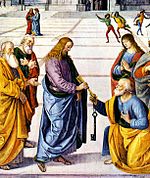- Pope Marcellus II
-
Marcellus II Papacy began 9 April 1555 (elected), 10 April 1555 (proclaimed) Papacy ended 1 May 1555 (22 days) Predecessor Julius III Successor Paul IV Orders Ordination 1535 Consecration 10 April, 1555
by Pope Paul IVCreated Cardinal 19 December, 1539 Personal details Birth name Marcello Cervini degli Spannochi Born 6 May 1501
Montefano, Marche, Papal StatesDied 1 May 1555 (aged 53)
Rome, Papal StatesOther Popes named Marcellus  Pope Marcellus II
Pope Marcellus II
Papal styles of
Pope Marcellus II
Reference style His Holiness Spoken style Your Holiness Religious style Holy Father Posthumous style None Pope Marcellus II (6 May 1501 – 1 May 1555), born Marcello Cervini degli Spannochi, was Pope from 9 April 1555 to 1 May 1555, succeeding Pope Julius III. Before his accession as Pope he had been Cardinal-Priest of Santa Croce in Gerusalemme. He is the most recent Pope to choose to retain his birth name as his regnal name upon his accession. After his death, it would be 415 years before another Pope would choose a name with an ordinal number less than IV (John Paul I).
Contents
Early Life
A native of Montefano, a small village near Macerata and Loreto[1] he was the son of Ricardo Cervini who was the Apostolic Treasurer in Ancona.[2] The family originated in Tuscany, in the town of Poliziano, which had once been subject to Siena, but later was under the control of Florence. Marcello had two half-brothers, Alexander and Romulus.[3] One of his sisters, Cinzia Cervini, married Vinzenzo Bellarmino, parents of Roberto Bellarmino. Marcello was educated locally, and at Siena and Florence, where he became proficient in writing Latin, Greek, and Italian. He also received instruction in jurisprudence, philosophy, and mathematics.[4] His father had an interest in astrology and upon discovering that his son's horoscope presaged high ecclesiastical honours, Riccardo set the young Cervini on a path to the priesthood.[5] Marcello Cervini was ordained a priest in 1535.
Priesthood
After his period of study at Siena, Cervini traveled to Rome in the company of the Delegation sent by Florence to congratulate the new Pope on his election. His father and Pope Clement VII were personal friends, and Marcello was made Scrittore Apostolico. He was set to work on astronomical and calendar studies, a project which was intended to bring the year back into synchronization with the seasons. After the Sack of Rome he fled home, but eventually returned and was taken into the household of Cardinal Alessandro Farnese senior. In 1534, after Farnese had become pope [Pope Paul III], Cervini was appointed a papal secretary (1534–49) and served as a close advisor to the pope's nephew Alessandro Farnese. He was made a papal Protonotarius.[6] He travelled in the suite of the Pope during the papal visit to Nice, where Paul III was promoting a truce between François I and Charles V. He then accompanied the young Cardinal Farnese on a trip to Spain, France and the Spanish Netherlands to help implement the terms of the truce. Paul III later appointed him bishop of Nicastro, Italy in 1539. Cervini was not, however, consecrated bishop until the day he himself was elected pope. While he was still on the embassy to the Netherlands, Paul III created him the Cardinal-Priest of Santa Croce in Gerusalemme on 19 December 1539. When, almost immediately after, Cardinal Farnese was recalled to Rome, Cervini stayed on as Nuntius. Over the course of next decade Cervini also became the apostolic administrator of the dioceses of Reggio and Gubbio.[2] His house in Rome became a center of Renaissance culture, and he himself corresponded with most of the leading humanists[7]
During the Council of Trent he was elected one of the council's three presidents, along with fellow cardinals Reginald Pole and Giovanni Maria Ciocchi del Monte (the future Pope Julius III). He continued to serve in that role throughout the remainder of Paul III's papacy after which he was replaced to placate the Holy Roman Emperor Charles V (1519–56). He was credited not only with defending orthodoxy and Church discipline, but also the universal claims of the Papacy in spiritual and temporal affairs, and with such vigor that the Emperor was affronted. In 1548 (or 1550) he was granted the supervision of the Vatican Library, with the title of Protettore della Biblioteca Apostolica.[8] The Apostolic Brief of his appointment, however, came from the new pope, Julius III on 24 May 1550, and he was named not Vatican Librarian, but Bibliothecarius Sanctae Romanae Ecclesiae because he was the first Cardinal to be in charge of the library.[9] During his administration, he employed the services of Marcello and Sirleto, as well as Onuphrio Panvinio (who was especially consulted in matters of Christian archaeology). He added more than 500 codices to the holdings of the Library, including 143 Greek codices, as his own entry book (which still survives as Vaticanus Latinus 3963) testifies.[10]
In the Conclave of 1549–50 to elect a successor to Paul III, fifty-one cardinals, including Marcello Cervini, participated at the opening on 3 December 1549. The initial candidates included Cardinals Pole, Sfondrati, Carpi and Ridolfi (who died on the night of 31 January). Pole, the favorite of the Emperor Charles V, came within two votes of being elected in the first scrutinies, but he could not attract any additional votes. Juan Alvarez de Toledo (Bishop of Burgos), another Imperial favorite was proposed, and he too failed, because of strong opposition from the faction of Cardinal Alessandro Farnese, nephew of the late Pope Paul III and from the French. On 12 December, five more French voters arrived, and though they could not advance the candidacy of their favorite, Ippolito d' Este, they did have Cardinal Cervini on their list of possible candidates. Farnese and his faction were also positively inclined toward him. Unfortunately, the Imperial faction was not.[11] Worst of all, on 22 December, Cardinal Cervini left the Conclave, suffering from a quartan fever. Finally, on 7 February 1550, the cardinals chose Giovanni Maria Ciocchi del Monte, who took the name Julius III.[12]
The first Conclave of 1555, following the death of Julius III (1550–55), involved a struggle between French interests in Italy (which had been favored by Julius III) and Imperial interests, which were intent on Church reform through a Church council, but with the Emperor controlling the outcome.[13] On 9 April 1555, on the evening of the fourth day of the papal conclave, Cervini was "adored" as Pope, despite efforts by cardinals loyal to the Emperor Charles V to block his election.[5] Next morning, a formal vote was taken in the Capella Paolina, in which all of the votes cast were for Cardinal Cervini except his own, which he cast for the Dean of the Sacred College of Cardinals, Giampietro Carafa. The new Pope chose to retain his birth name, the most recent Pope to do so, reigning as Marcellus II. He was both ordained as a bishop and crowned Pope on the next day in a subdued ceremony on account of it falling during the Lenten season.[14]
Papacy
Though Marcellus II desired to reform many of the inner workings of the church, his feeble constitution succumbed to the fatigues of the conclave, the exhausting ceremonies connected with his ascension, the anxieties arising from his high office, and overexertion in his performance of the pontifical functions of the Holy Week and Easter.[15] He quickly fell ill. He was bled, and appeared to begin to recover. In an audience he gave to the Cardinals, who wanted him to sign the Electoral Capitulations from the Conclave and to guarantee that he would make no more cardinals than those agreements allowed, he refused to sign, stating that he would show his intent by deeds not words. In his first audience with the Ambassadors of France and Spain, he warned the Ambassadors that their monarchs should keep the peace that had been agreed upon, and that if they did not, not only would they be sent Nuncios and Legates, but that the Pope himself would come and admonish them. He wrote letters to the Emperor, to Queen Mary of England, and to Cardinal Reginald Pole (in which he confirmed Pole's Legateship in England).[16] When the Spanish Ambassador asked for pardon for having killed a man, the Pope replied that he did not want to start his reign with such auspices as absolution from homicide, and ordered the appropriate tribunals to observe the law. He did not want his relatives descending on Rome, nor did he want them to be enriched beyond the station of a member of the nobility, and he did not allow his two nephews, Riccardo and Herennius (sons of his half-brother Alexander), who lived in Rome under his care, to have formal visits. He instituted immediate economies in Vatican expenditures. On 28 April, he was able to receive the Duke of Urbino in audience, and on the 29 April, the Duke of Ferrara. He also gave audience to four cardinals, Farnese, D'Este, Louis de Guise and Ascanio Sforza, the leaders of the French faction in the recent Conclave. That night he had difficulty sleeping. On the morning of the 30th he suffered a stroke (hora XII apoplexi correptus) and slipped into a coma. That night he died, on the 22nd day after his election.[5]
Legacy
Marcellus II had a high reputation for integrity, tact and ability. Palestrina's Missa Papae Marcelli (dating from 1565 or before [17]), one of the glories of polyphonic sacred choral music, is traditionally believed to have been composed in his memory, ca. 1562.[2] Having reigned for just 22 calendar days, Pope Marcellus II ranks sixth on the list of 10 shortest-reigning Popes. His successor was Giampietro Carafa, Dean of the Sacred College of Cardinals Pope Paul IV (1555–59).
References
- ^ Lorenzo Cardella, Memorie storiche de' cardinali della Santa Romana Chiesa Tomo Quarto (Roma: Pagliarini 1793) pp. 225.
- ^ a b c Catholic Encyclopedia, Pope Marcellus II (1913)
- ^ Onuphrio Panvinio, "Marcellus II" in Historia B. Platinae de vitis pontificum Romanorum ... ad Paulum II...annotationum Onuphrii Panvinii ... cui, eiusdem Onuphrii ... Pontificum vitae usque ad Pium V (Colonia: apud: Maternum Cholinum MDLXVIII) [Panvinio, "Life of Marcellus II"], 423.
- ^ Cardella, 225: Nella patria, in Siena, in Firenze attese allo studio delle lingue latina, greca, e italiana, e in tutte scriveva con gran facilità, ed eleganza. Non trascurò le scienze più gravi, e nella giurisprudenza, filosofia, e mattematica, fece lieti progressi.
- ^ a b c Valérie Pirie. The Triple Crown: An Account of the Papal Conclaves From the Fifteenth Century to the Present Day. New York: G.P. Putnam's Sons, 1936.
- ^ Panvinio, 424.
- ^ Cardella, 226: la di lui famiglia piena fosse di uomini dotti, scientifici, e letterati, ed egli mantenesse stretta corrispondenza con Angelo Coluzio, Costantino Lascari, ed altri uomini dotti, ed eruditi di quei tempi.
- ^ Isidoro Carini, La Biblioteca Vaticana seconda edizione (Roma 1893), 59–61.
- ^ Domenico Zanelli, La Biblioteca Vaticana (Roma 1`857) 28–29.
- ^ Zanelli, loc. cit.
- ^ Sede Vacante of 1549-1550
- ^ Onuphrio Panvinio, "Marcellus II" in Historia B. Platinae de vitis pontificum Romanorum ... ad Paulum II...annotationum Onuphrii Panvinii ... cui, eiusdem Onuphrii ... Pontificum vitae usque ad Pium V (Colonia: apud: Maternum Cholinum MDLXVIII), 425: Defuncto Paulo III quum in eius locum isdem Cardinalius Iulius III vocatus, quo cum arctissimae amicitiae nexu coniunctus erat, pontifex factus esset, absens (conclave enim adversa valetudine conflictatus exierat) primum per nuntium ei gratulatus est, mox viribus parumper recuperatis, cum Urbe egredi ad salubriora loca medicorum consilio statuisset, se sellae impositus, ad Pontificem deferri curavit.
- ^ Sede Vacante of April, 1555
- ^ Onuphrio Panvinio, who was present, recorded the event: "Anno Dominicae Nativitatis MDLV, postridie quam PP Marcellus creatus est, videlicet die Mercurii IIII Idus Aprilis [April 10, 1555], maioris hebdomadae, instantibus magnis solennibus, Coenae Domini, Veneris Sancti, & Paschatis, ne tot solennitates sine Pontifice (qui sacra omnia faceret) transigerentur, quum prius in aurora eius creatio, more Maiorum, per Archidiaconum S.R.E. Franciscum Pisanum Venetum, Diac. Cardinalem S. Marci, in Palatio facta esset, haud multo post ante aram maximam principis Apostolorum suae coronationis & Romani Pontificatus insignia per eundem Archidiaconum suscepit, data benedictione a Ioanne Bellaio Episcopo Cardinale Portuensi & S. Rufinae." (Onuphrio Panvinio, Epitome Pontificum Romanorum a S. Petro usque ad Paulum IIII. Gestorum (videlicet) electionisque singulorum & Conclavium compendiaria narratio (Venice: Jacob Strada 1557), p. 423.)
- ^ Panvinio, "Life of Marcellus II", 430: Quum satis (ut dixi) firmus non esset viribus, & propterea anno superiori diu etiam febre laborasset, corpore quoque tam comitiorum incommodis, quam obeundis publicis muneribus, quae vetere Christiani populi instituto, annuis Dominici Cruciatus [Good Friday] & Resurrectionis [Easter] diebus per Maximum Pontificem fieri consuerunt, fatigato, duodecimo pontificatus die gravius e pituita, & non levi febre decubuit.
- ^ Paul Friedmann (editor), Les dépêches de Giovanni Michiel, Ambassadeur de Venise en Angleterre pendent les années 1554–1557 (Venice 1869), p. 36, dispatch of May 6, 1555. This is confirmed by Sir John Masone, the English ambassador in Bruxelles: William B. Turnbull (editor), Calendar of State Papers, Foreign Series, of the Reign of Mary, 1553–1558 (London 1861), p. 164 #348 (April 26, 1555).
- ^ Catholic Encyclopedia, Giovanni Pierluigi da Palestrina (1913).
Catholic Church titles Preceded by
Julius IIIPope
1555Succeeded by
Paul IVCatholic Church Organizations, Papacy, Teachings and Liturgical TraditionsHistory Jesus · Twelve Apostles · Early Christianity · History of the Papacy · Ecumenical Councils · Missions · Great Schism of East · Crusades · Great Schism of West · Protestant Reformation · Counter-Reformation · Catholic Church by country
Hierarchy Pope · Cardinals · Patriarchs · Major Archbishops · Primates · Metropolitans · Archbishops · Diocesan BishopsTheology Sacraments Mariology Doctors of
the ChurchAlbertus Magnus · Ambrose · Anselm of Canterbury · Anthony of Padua · Thomas Aquinas · Athanasius of Alexandria · Augustine of Hippo · Basil of Caesarea · Bede · Robert Bellarmine · Bernard of Clairvaux · Bonaventure · Petrus Canisius · Catherine of Siena · Peter Chrysologus · John Chrysostom · Cyril of Alexandria · Cyril of Jerusalem · Peter Damian · Ephrem the Syrian · Francis de Sales · Gregory of Nazianzus · Gregory the Great · Hilary of Poitiers · Isidore of Seville · Jerome · John of Damascus · John of the Cross · Lawrence of Brindisi · Leo the Great · Alphonsus Maria de Liguori · Teresa of Ávila · Thérèse of LisieuxPope Benedict XVI Preceding Popes Orders and
SocietiesVatican II Particular Churches
sorted by
Liturgical TraditionsAlexandrian · Coptic · Ethiopic · Antiochian · Maronite · Syriac · Syro-Malankara · Armenian · Armenian · Byzantine · Albanian · Belarusian · Bulgarian · Croatian · Greek · Hungarian · Italo-Albanian · Macedonian · Melkite · Romanian · Russian · Ruthenian · Slovak · Ukrainian · East Syrian · Chaldean · Syro-Malabar · Latin · Roman · Anglican Use · Sarum · Ambrosian · MozarabicHistory of the Catholic Church General History of the Catholic Church · History of the Papacy · History of the Roman Curia · Catholic Ecumenical Councils · Timeline of the Catholic Church · History of Christianity · Role of the Catholic Church in Western civilization · Art in Roman Catholicism · Catholic religious order · Christian monasticism · Papal States
Church beginnings Constantine the Great to
Pope Gregory IConstantine the Great and Christianity · Arianism · Basilica of St. John Lateran · First Council of Nicaea · Pope Sylvester I · First Council of Constantinople · Biblical canon · Jerome · Vulgate · First Council of Ephesus · Council of Chalcedon · Benedict of Nursia · Second Council of Constantinople · Pope Gregory I · Gregorian chant
Early Middle Ages Third Council of Constantinople · Saint Boniface · Byzantine Iconoclasm · Second Council of Nicaea · Charlemagne · Pope Leo III · Fourth Council of Constantinople · East–West Schism
High Middle Ages Pope Urban II · Investiture Controversy · Crusades · First Council of the Lateran · Second Council of the Lateran · Third Council of the Lateran · Pope Innocent III · Latin Empire · Francis of Assisi · Fourth Council of the Lateran · Inquisition · First Council of Lyon · Second Council of Lyon · Bernard of Clairvaux · Thomas Aquinas
Late Middle Ages Protestant Reformation/
Counter-ReformationBaroque Period to the
French Revolution19th century Pope Pius VII · Pope Pius IX · Dogma of the Immaculate Conception of the Virgin Mary · Our Lady of La Salette · Our Lady of Lourdes · First Vatican Council · Papal infallibility · Pope Leo XIII · Mary of the Divine Heart · Prayer of Consecration to the Sacred Heart · Rerum Novarum
20th century Pope Pius X · Our Lady of Fátima · Persecutions of the Catholic Church and Pius XII · Pope Pius XII · Pope Pius XII Consecration to the Immaculate Heart of Mary · Dogma of the Assumption of the Virgin Mary · Pope John XXIII · Second Vatican Council · Pope Paul VI · Pope John Paul I · Pope John Paul II
21st century By country or region Brazil · Cuba · France · Germany · Hispano-America · Ireland · Japan · Mexico · Spain · United States · Venezuela
Categories:- Popes
- Italian popes
- People from the Province of Macerata
- Participants in the Council of Trent
- 1501 births
- 1555 deaths
- 16th-century Italian people
Wikimedia Foundation. 2010.




